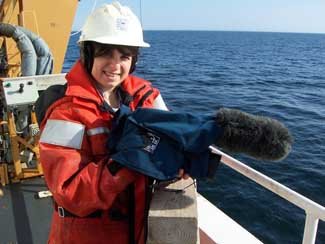Walruses Go with the Floes
One of the most peculiar things about walruses is that they are always touching each other. They lie in gregarious groups on the ice. They do the same in captivity. Carleton Ray, a walrus researcher and former curator of the New York Aquarium, said if a young walrus was asleep in a corner and a keeper came in the enclosure, when the young walrus woke up it would maneuver itself and sit on the keeper. That’s a 200-pound lap dog! Carleton also said that it is sometimes hard to count walruses in the wild because they lie piled on top of each other. It was hard to tell how many were underneath or which flippers belonged to whom.
The Bering Sea is a prime feeding ground for walruses because it is a shallow, productive body of water with ice floes. Walruses need floating platforms so they can haul out of the water to rest after hours—and sometimes days—of continuous feeding on the seafloor. These dynamic divers can scarf down around six to nine clams a minute by sucking the soft bodies out of the shell. Walruses play important roles in the marine ecosystem. Like gardeners turning soil, walruses churn the seafloor as they troll for food, releasing nutrients that other animals consume into the water. (Walrus photo courtesy of Karen Frey.)
Like so many animals in the Bering Sea, walruses depend on sea ice for survival. If the ice melts too early, the walrus population, well, goes with the floes. The Healy encountered about 1500 walruses in the northern Bering Sea a few days ago. We’ve sailed past small groups since then. Carleton Ray and other researchers on this cruise are interested in where the walruses go when the sea ice disappears from the Bering Sea.
The Bering Sea is a prime feeding ground for walruses because it is a shallow, productive body of water with ice floes. Walruses need floating platforms so they can haul out of the water to rest after hours—and sometimes days—of continuous feeding on the seafloor. These dynamic divers can scarf down around six to nine clams a minute by sucking the soft bodies out of the shell. Walruses play important roles in the marine ecosystem. Like gardeners turning soil, walruses churn the seafloor as they troll for food, releasing nutrients that other animals consume into the water. (Walrus photo courtesy of Karen Frey.)

Like so many animals in the Bering Sea, walruses depend on sea ice for survival. If the ice melts too early, the walrus population, well, goes with the floes. The Healy encountered about 1500 walruses in the northern Bering Sea a few days ago. We’ve sailed past small groups since then. Carleton Ray and other researchers on this cruise are interested in where the walruses go when the sea ice disappears from the Bering Sea.


<< Home